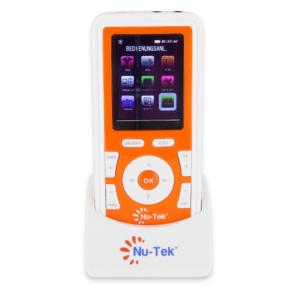Hier geben wir Ihnen einen Überblick zu den wichtigsten Begriffen aus den Bereichen funktionelle Elektrostimulation (FES), transkutane elektrische Nervenstimulation (TENS) und elektrische Muskelstimulation (EMS).
| Begriff | Erklärung |
| Abduktion | Seitliche Wegführung (Fuß kippt nach → lateral) – Gegenbewegung der → Adduktion. Bewegung des Beines oder Fußes vom Körper weg. |
| Adduktion | Seitliche Heranführung (Fuß kippt nach → medial) – Gegenbewegung der → Abduktion. Bewegung des Beines oder Fußes zum Körper hin. |
| Basalganglien | Gruppe von Endhirn- und Zwischenhirnkernen (Gebiete aus grauer Substanz), die unter der Großhirnrinde lokalisiert sind. |
| Dorsalflexion | Beschreibt die Kontraktion/Bewegung des Fußes im Sprunggelenk nach “oben” in Richtung Fußrücken. |
| EMS | Elektrische Muskel-Stimulation: Niederfrequente elektrische Impulse stimulieren Nerven, was wiederum zu einer Muskelkontraktion führt. |
| Eversion | Kombinierte Bewegung aus → Abduktion, → Dorsalflexion und → Pronation. Der Fuß kippt nach → lateral. |
| Fibularisnerv | → Peroneusnerv lat. Nervus fibularis Synonym für Peroneusnerv/Wadenbeinnerv |
| Fibulaköpfchen | lat. Caput fibulae Das Fibulaköpfchen/Wadenbeinköpfchen ist ein tastbarer Knochenpunkt und bildet das Ende des Wadenbeins (lat. Fibula). Es ist Ansatzstelle von Sehnen und Bändern und stellt gleichzeitig einen Gelenkkopf dar. Direkt unterhalb des Fibulaköpfchens verläuft der → Peroneusnerv. |
| FES – Funktionelle Elektrostimulation | Nerven werden über die Haut mit Stromimpulsen stimuliert, um so eine Muskelkontraktion herbeizuführen. |
| Fußheberschwäche | Beschreibt eine Bewegungseinschränkung des Fußes: Der Fuß lässt sich nicht mehr anheben und schleift beim Gehen über den Boden. Die Stolper- und Sturzgefahr ist dabei extrem hoch. Ursache ist oft eine → Peroneusparese. |
| Innervieren | Innervieren (Innervation) beschreibt die funktionelle Versorgung eines Körperteiles oder einer Gewebestruktur mit Nervenzellen und Nervenfasern. Die Innervation erlaubt die Steuerung von Körpervorgängen und -bewegungen durch Reizausübung und Reizwahrnehmung. |
| Inversion | Inversion |
| Ischiasnerv | lat. Nervus ischiadicus Ischiasnerv |
| Lateral | Seitlich von der Körpermitte abgewandt |
| Medial | Zur Körpermitte hin orientiert |
| Musculus biceps femoris | Zweiköpfiger Muskel des Oberschenkels, auch Beinbeuger genannt |
| Musculus tibialis anterior | Fußhebermuskel, vorderer Schienbeinmuskel |
| Nervus fibularis | Fibularisnerv, Nerv im Unterschenkel |
| Nervus peroneus profundus | Tiefer Wadenbeinnerv |
| Nervus peroneus superficialis | Oberflächlicher Wadenbeinnerv |
| Nervus peroneus | Peroneusnerv |
| Nervus tibularis | Schienbeinnerv |
| Patella | Kniescheibe; eine flache, gewölbte von vorn betrachtet dreieckige Knochenplatte, die vor dem Kniegelenk lokalisiert ist. |
| Peroneuslähmung | Synonym → für Peroneusparese, → Fußheberschwäche |
| Peroneusnerv | → Fibularisnerv lat. Nervus peroneus Peroneusnerv |
| Peroneusparese | Eine Läsion des Peroneusnervs, die zu einer → Fußheberschwäche führen kann. Dabei kann der motorische Befehl zur → Dorsalflexion nicht mehr an die Muskulatur weitergegeben werden: Betroffene können den Fuß nicht mehr heben und schleifen beim Gehen oft mit der Fußspitze über den Boden. |
| Plantarflexion | Kontraktion/Bewegung des Fußes nach “unten” in Richtung Fußsohle |
| Pronation | Drehung des Fußes um seine Längsachse, bei der der äußere Fußrand gehoben und der innere gesenkt wird. |
| Schienbeinnerv | lat. Nervus tibularis Der Schienbeinnerv ist eine Verzweigung des Ischiasnervs. Er zieht an der Rückseite des Beines entlang und → regt Teile der Muskulatur an Oberschenkel, Unterschenkel und Fuß sowie Hautareale an Wade, Ferse und Fußsohle an. |
| Supination | “Zurückgebogene” Stellung des Fußes; Hebung des inneren Fußrandes bei gleichzeitiger Senkung des äußeren bzw. Hebung des medialen Randes |
| TENS | Transkutane Elektrische Nerven-Stimulation: über die Haut werden Nervenbahnen stimuliert, um die Schmerzwahrnehmung des Patienten zu beeinflussen. |
| Tibia | Schienbein/Schienbeinknochen; der zweitlängste Knochen des menschlichen Skeletts |
| Wadenbeinköpfchen | Fibulaköpfchen |
| Wadenbeinnerv | Synonym für → Peroneusnerv, → Fibularisnerv |

inkl. 19 % MwSt.
zzgl. Versandkosten

inkl. 19 % MwSt.
zzgl. Versandkosten

inkl. MwSt.
zzgl. Versandkosten
Dieses Produkt weist mehrere Varianten auf. Die Optionen können auf der Produktseite gewählt werdenHELLER MEDIZINTECHNIK GmbH & Co. KG ist seit über 25 Jahren als zertifiziertes Unternehmen in der Medizintechnik tätig und verfügt über langjährige Erfahrung in der Gestaltung von Lösungen im Bereich der elektrischen Nerven- und Muskelstimulation.
2025 © HELLER MEDIZINTECHNIK GmbH & Co. KG
Liebe Kundinnen und Kunden,
liebe Besucherinnen und Besucher unserer Website,
über die kommenden Feiertage gönnen wir uns eine kurze Weihnachtspause.
Nachfolgend informieren wir Sie über unsere Erreichbarkeit:
An diesen Tagen sind wir für Sie da:
An diesen Tagen bleibt unser Unternehmen geschlossen:
Ab Montag, 5. Januar 2026, sind wir wieder vollständig für Sie da.
Wir bedanken uns herzlich für Ihr Vertrauen, Ihr Interesse an unseren medizinisch‑therapeutischen Lösungen und Ihren Besuch auf unserer Website.
Wir wünschen Ihnen und Ihren Familien